Comparative Investigation of the Undercooling Capacity and Single-Crystal Castability of Some Ni-Based Superalloys
Abstract
1. Introduction
2. Experimental Section
2.1. Materials
2.2. Undercooling Experiment
2.3. Casting Experiment of SC Blades
3. Results and Analysis
3.1. Evaluation of Undercooling Capacity
3.2. Inspection of Stray Grains in Blade Castings
3.3. Analysis of Formation Mechanism of SG
4. Conclusions
- Highly undercoolable alloys having an undercooling capacity of over 40 K. Using this type of alloy, SC blades without macroscopic SG defects could be produced easily. However, the occurrence of dendrite fragmentation in the platforms due to the locally high undercooling may result in microscopic defects.
- The alloys having medium undercooling capacity between 20 and 30 K. The alloys with this moderate undercooling capacity exhibit optimal castability for SC blade castings. Both the macroscopic SG defects and the microscopic fragmentation of dendrite arms can be avoided.
- The alloys having very low undercooling capacity of only around 10 K. The undercooling capacity for these alloys is so low that it is normally exceeded by the geometrical undercooling established at the platform extremities, so these alloys are prone to the formation of SGs. It is very difficult to produce SC components free of SGs using this type of alloy.
Author Contributions
Funding
Institutional Review Board Statement
Informed Consent Statement
Data Availability Statement
Conflicts of Interest
References
- Pollock, T.; Murphy, W. The breakdown of single-crystal solidification in high refractory nickel-base alloys. Metall. Trans. A 1996, 27, 1081–1094. [Google Scholar] [CrossRef]
- Ma, D.; Wang, F.; Wu, Q.; Bogner, S.; Bührig-Polaczek, A. Innovations in casting techniques for single crystal turbine blades of superalloys. In Superalloys; Hardy, M., Huron, E., Glatzel, U., Griffin, B., Lewis, B., Rae, C., Seetharaman, V., Tin, S., Eds.; TMS: Warrendale, PA, USA, 2016; pp. 237–246. [Google Scholar]
- Wagner, A.; Shollock, B.A.; McLean, M. Grain structure development in directional solidification of nickel-base superalloys. Mater. Sci. Eng. A 2004, 374, 270–279. [Google Scholar] [CrossRef]
- Vehn, M.; Dedecke, D.; Paul, U.; Sahm, P.R. Undercooling related casting defects in SC turbine blades. In Proceedings of the International Symposium on Superalloys, Champion, PA, USA, 22–26 September 1996; pp. 471–479. [Google Scholar]
- Zhou, Y. Formation of stray grains during directional solidification of a nickel-based superalloy. Scr. Mater. 2011, 65, 281–284. [Google Scholar] [CrossRef]
- Bogner, S.; Ivanova, E.; Müller, M.; Wang, F.; Ma, D.; Bührig-Polaczek, A. Investigation of the undercoolability of Ni-Based alloys using high temperature thermal analysis. Metals 2015, 5, 1971–1983. [Google Scholar] [CrossRef]
- Yang, X.L.; Dong, H.B.; Wang, W. Microscale simulation of stray grain formation in investment cast turbine blades. Mater. Sci. Eng. A 2004, 386, 129–139. [Google Scholar] [CrossRef]
- Xuan, W.; Ren, Z.; Liu, H. Formation of stray grains in directionally solidified Ni-based superalloys with cross-section change regions. Mater. Sci. Forum 2013, 747–748, 535–539. [Google Scholar] [CrossRef]
- Xuan, W.; Ren, Z.; Li, C.; Ren, W.; Chen, C. Formation of stray grain in cross section area for Ni-basedd superalloy during directional solidification. IOP Conf. Ser. Mater. Sci. Eng. 2011, 27, 012035. [Google Scholar] [CrossRef]
- Zhang, J.; Huang, T.; Liu, L.; Hu, F. Advances in solidification characteristics and typical casting defects in nickel-based single crystal superalloys. Acta Metall. Sin. 2015, 51, 1163–1178. [Google Scholar]
- Xuan, W.; Ren, Z.; Li, C. Experimental evidence of the effect of a high magnetic field on the stray grains formation in cross-section change region for Ni-based superalloy during directional solidification. Metall. Mater. Trans. A 2015, 46, 1461–1466. [Google Scholar] [CrossRef]
- Paul, U.; Sahm, P.; Goldschmidt, D. Inhomogeneities in single-crystal components. Mat. Sci. Eng. A 1993, 173, 49–54. [Google Scholar] [CrossRef]
- Ma, D.; Wang, F.; Wu, Q.; Guo, J.; Xu, F.; Liu, Z.; Ou, S. Temperature evolution and grain defect formation during single crystal solidification of a blade cluster. China Foundry 2017, 14, 456–460. [Google Scholar] [CrossRef][Green Version]
- Wang, F.; Wu, Z.; Huang, C.; Ma, D.; Bührig-Polaczek, A. Three-dimensional dendrite growth within the shrouds of single crystal blades of a nickel-based superalloy. Metall. Mater. Trans. A 2017, 48, 5924–5939. [Google Scholar] [CrossRef]
- Ma, D.; Bührig-Polaczek, A. Development of heat-conductor technique for single crystal components of superalloys. Int. J. Cast Met. Res. 2009, 22, 422–429. [Google Scholar] [CrossRef]
- Ma, D.; Bührig-Polaczek, A. Application of heat-conductor technique to production of single crystal turbine blade. Metall. Mater. Trans. B 2009, 40, 738–748. [Google Scholar] [CrossRef]
- Xuan, W.D.; Zhang, H.W.; Shao, W.; Ren, Z. Formation Mechanism of stray grain of nickel-based single-crystal superalloy under a high magnetic field during directional solidification. Metall. Mater. Trans. B 2019, 50, 27–31. [Google Scholar] [CrossRef]
- Li, Y.F.; Liu, L.; Sun, D.J.; Hu, F. Quantitative analysis of withdrawal rate on stray grain formation in the platforms of a Ni-Based single crystal dummy blade. J. Alloy. Compd. 2019, 773, 432–442. [Google Scholar] [CrossRef]
- Qiu, F.; Bu, K.; Zheng, B.; Tian, G. Control of edge plate stray grain of single-crystal turbine blade by using process bar method. Int. J. Met. 2020, 14, 144–154. [Google Scholar] [CrossRef]
- Yang, Z.Y.; Liu, C.G.; Hu, S.S.; Zheng, S.J.; Luo, Y.S.; Dai, S.L. Influence of platform position on stray grain nucleation in Ni-based single-crystal dummy blade clusters. China Foundry 2021, 18, 442–449. [Google Scholar] [CrossRef]
- Ma, D.; Wu, Q.; Bührig-Polaczek, A. Undercoolability of Superalloys and Solidification Defects in Single Crystal Components. Adv. Mat. Res. 2011, 278, 417–422. [Google Scholar] [CrossRef]
- Ma, D. Novel casting processes for single crystal turbine blades of superalloys. Front. Mech. Eng. 2018, 13, 3–16. [Google Scholar] [CrossRef]
- Ma, D.; Wang, F.; Guo, J.; Xu, W. Single Crystal Castability and Undercoolability of PWA1483 Superalloy. Acta Metall. Sin. 2019, 32, 1415–1420. [Google Scholar] [CrossRef]

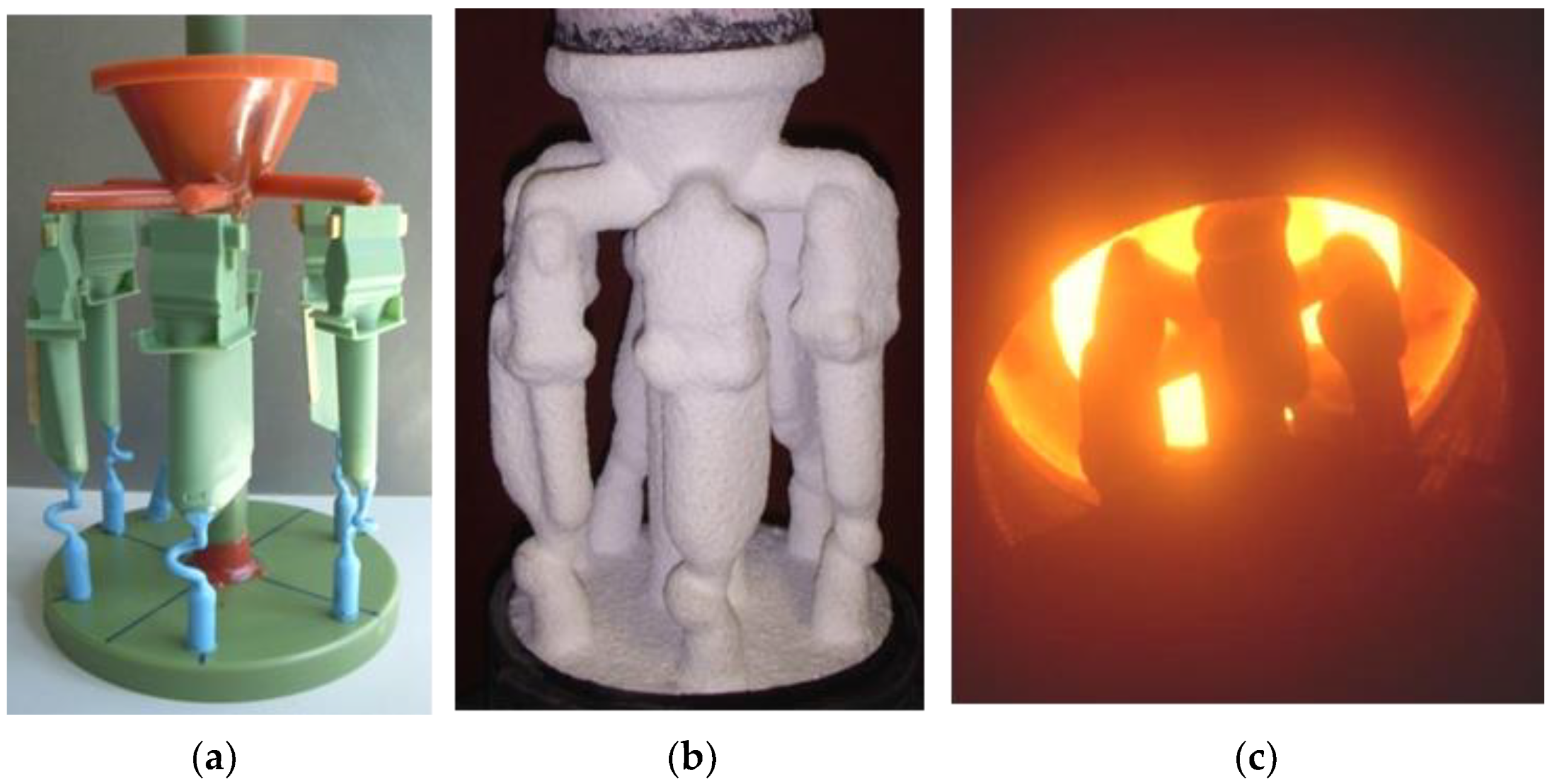

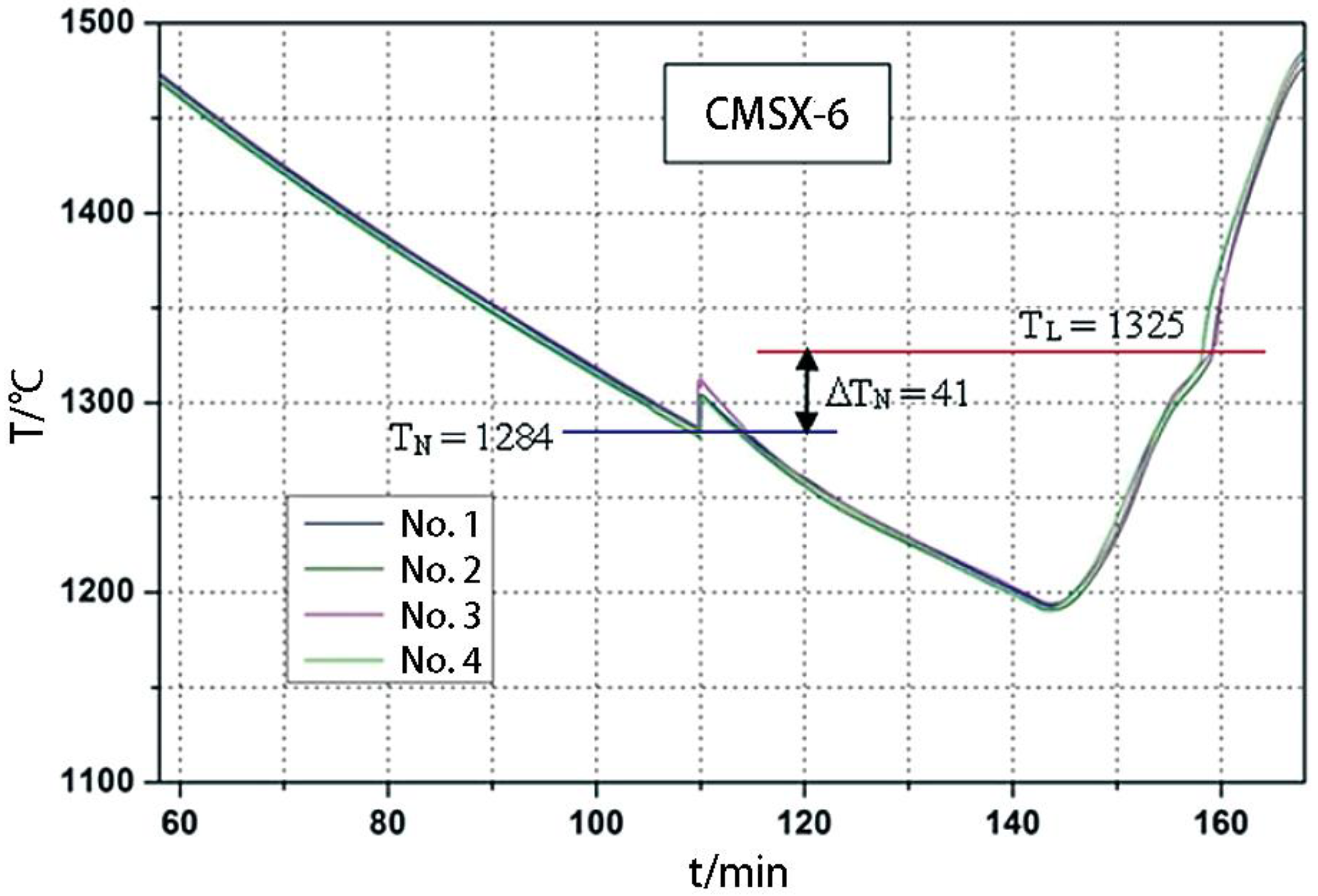
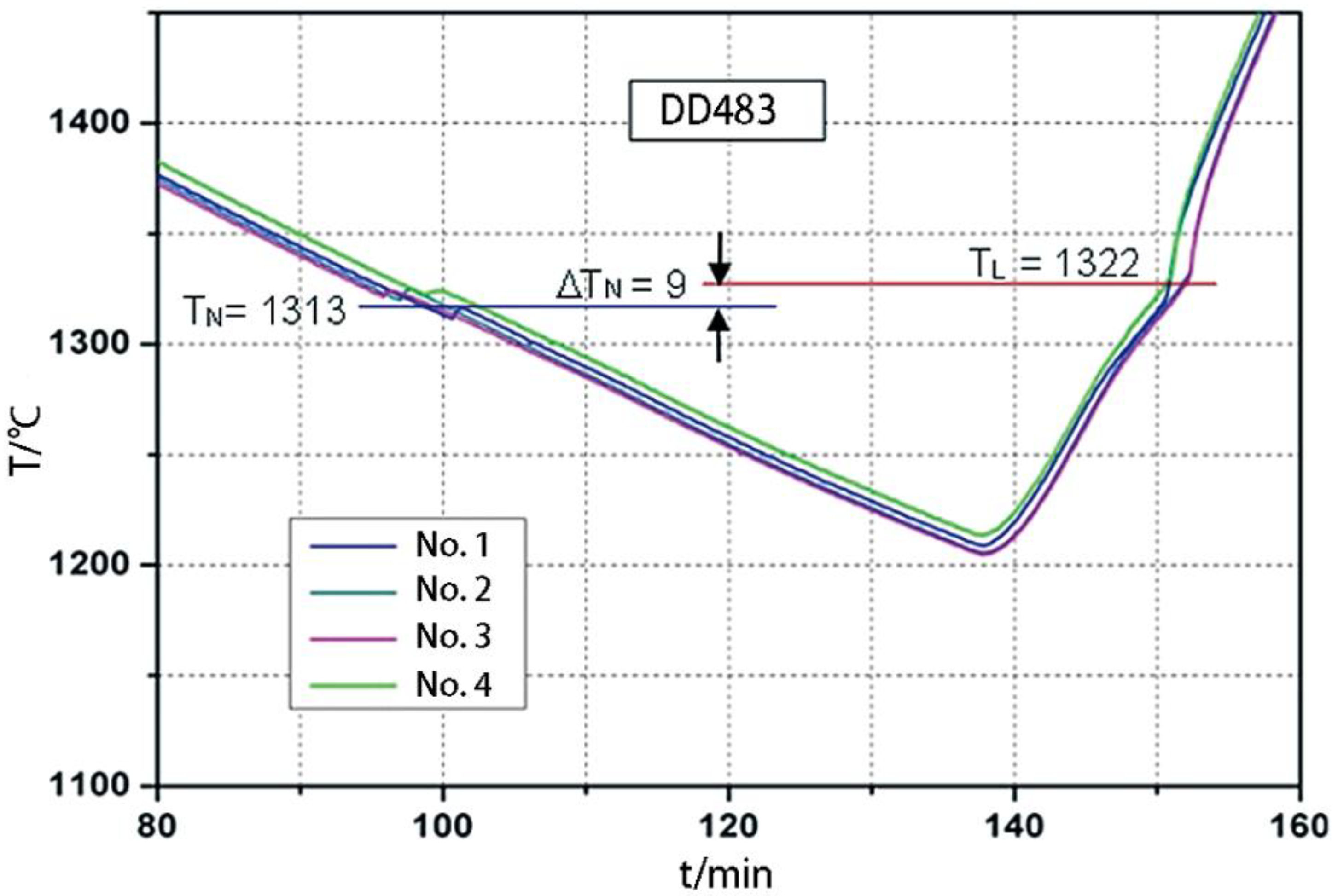
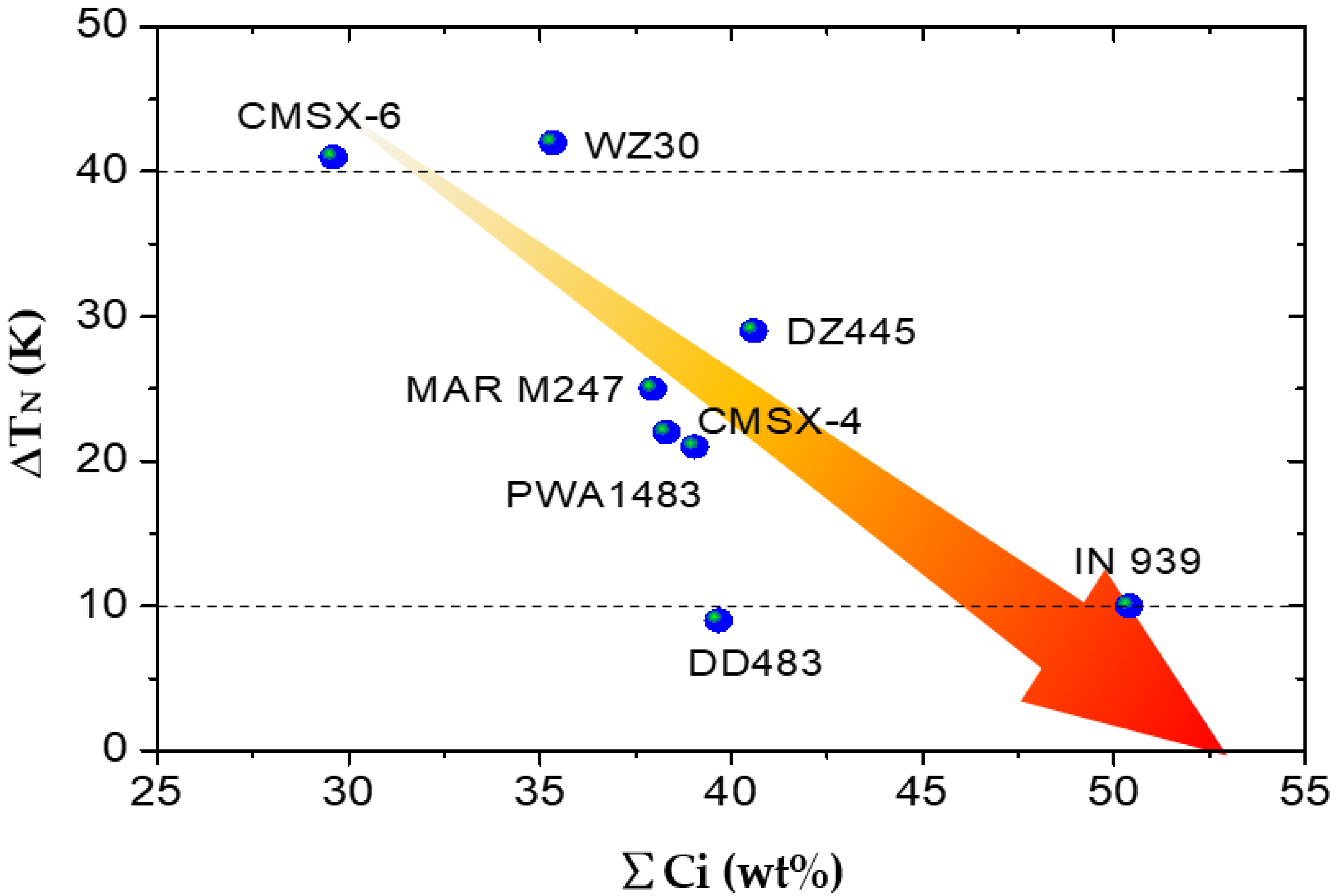
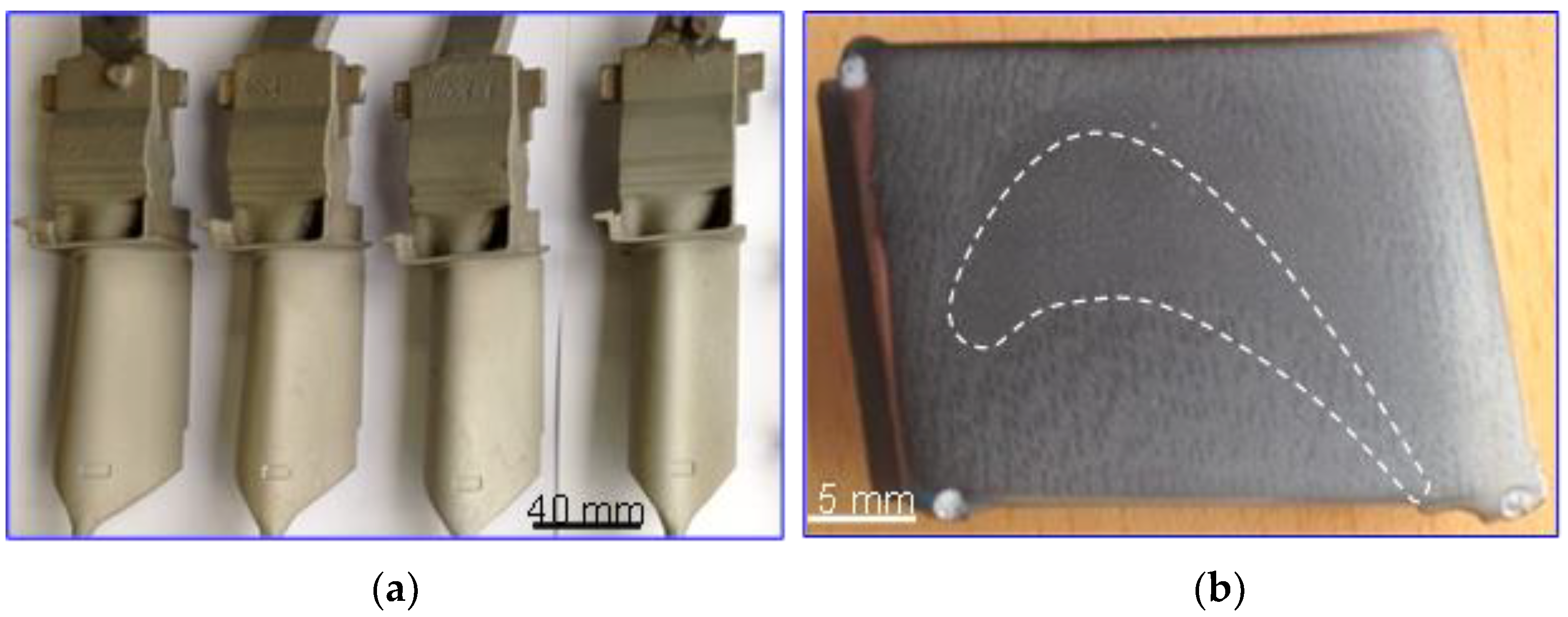

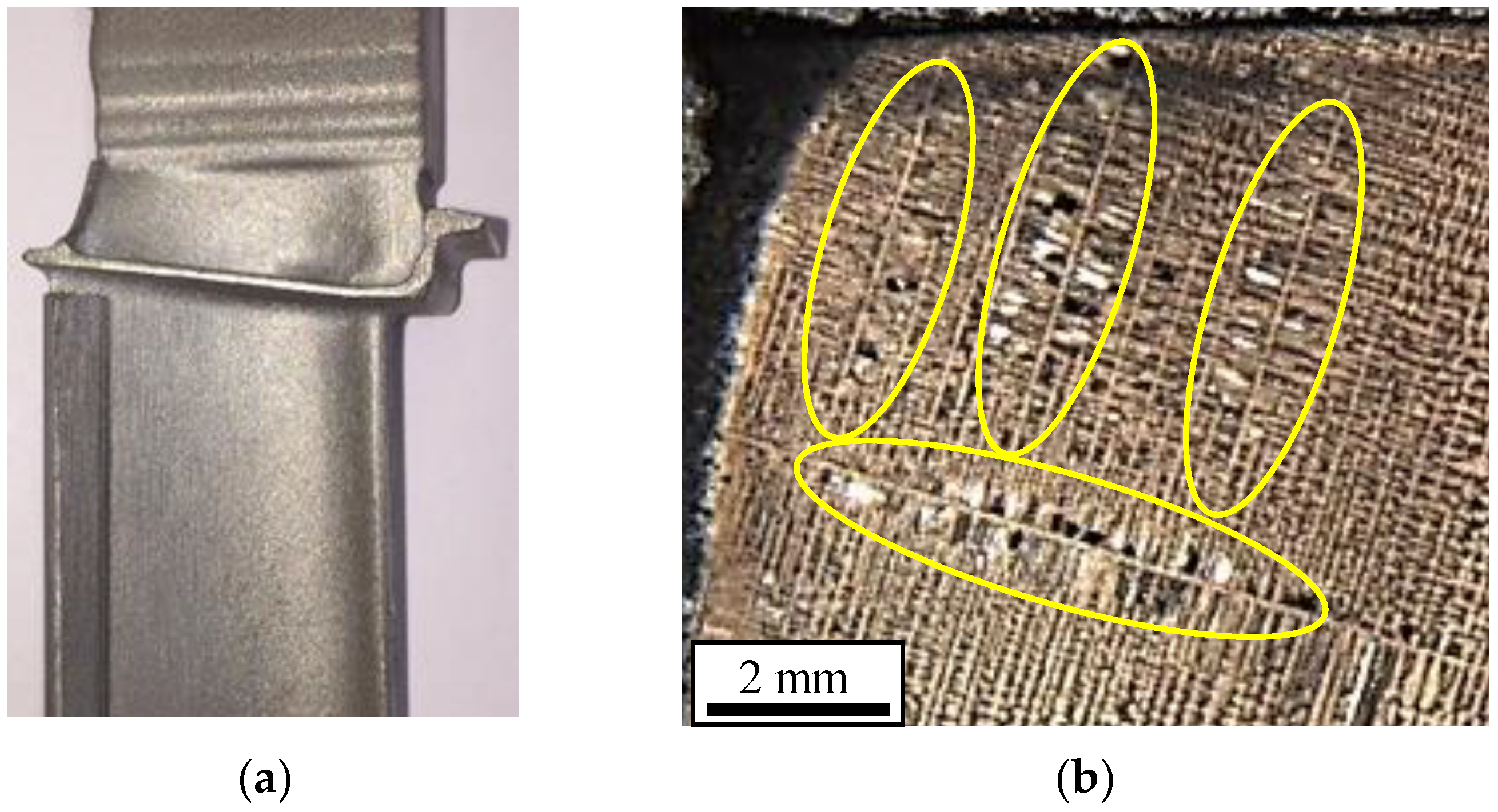
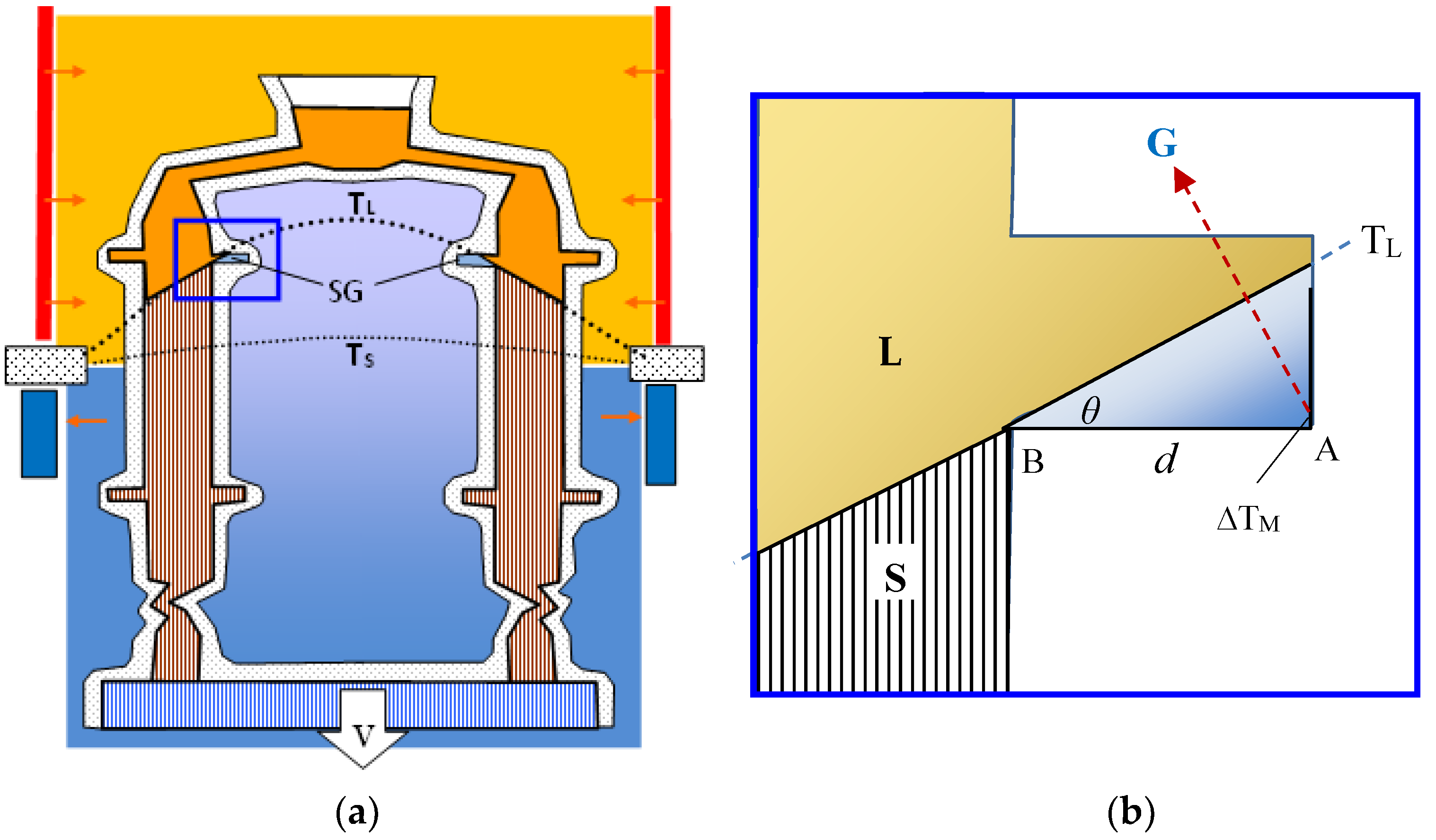
| Alloy | Alloying Element | |||||||||
|---|---|---|---|---|---|---|---|---|---|---|
| Cr | Co | W | Mo | Al | Ti | Ta | Re | Hf | Total (∑Ci) | |
| CMSX-6 | 10.0 | 5.0 | - | 3.0 | 4.8 | 4.7 | 2.0 | - | 0.1 | 29.6 |
| WZ30 | 3.5 | 6.0 | 6.5 | 0.4 | 5.8 | 0.15 | 8.0 | 4.95 | 0.03 | 35.33 |
| MAR M247 | 8.2 | 9.2 | 9.5 | 0.5 | 5.6 | 0.7 | 3.2 | - | 1.05 | 37.95 |
| CMSX-4 | 6.5 | 9.0 | 6.0 | 0.6 | 5.6 | 1.0 | 6.5 | 3.0 | 0.1 | 38.3 |
| PWA1483 | 11.98 | 8.7 | 3.83 | 1.81 | 3.63 | 3.99 | 5.09 | - | 0.01 | 39.04 |
| DZ445 | 13.15 | 10.0 | 4.50 | 1.76 | 4.13 | 2.30 | 4.75 | - | - | 40.59 |
| DD483 | 12.18 | 9.23 | 3.89 | 1.85 | 3.53 | 4.00 | 4.98 | - | 0.01 | 39.67 |
| IN939 | 22.4 | 19.0 | 2.0 | - | 1.9 | 3.7 | 1.4 | - | - | 50.4 |
| Alloy | Liquidus Temperature TL (°C) | Nucleation Temperature TN (°C) | Nucleation Undercooling ΔTN = TL − TN (K) | Undercooling Capacity Level |
|---|---|---|---|---|
| WZ30 | 1416 | 1374 | 42 | High |
| CMSX-6 | 1325 | 1284 | 41 | |
| DZ445 | 1347 | 1318 | 29 | Medium |
| MAR M247 | 1368 | 1343 | 25 | |
| CMSX-4 | 1372 | 1350 | 22 | |
| PWA1483 | 1328 | 1307 | 21 | |
| IN 939 | 1326 | 1316 | 10 | Low |
| DD483 | 1322 | 1313 | 9 |
Disclaimer/Publisher’s Note: The statements, opinions and data contained in all publications are solely those of the individual author(s) and contributor(s) and not of MDPI and/or the editor(s). MDPI and/or the editor(s) disclaim responsibility for any injury to people or property resulting from any ideas, methods, instructions or products referred to in the content. |
© 2022 by the authors. Licensee MDPI, Basel, Switzerland. This article is an open access article distributed under the terms and conditions of the Creative Commons Attribution (CC BY) license (https://creativecommons.org/licenses/by/4.0/).
Share and Cite
Ma, D.; Zhao, Y.; Xu, W.; Xu, F.; Wei, J.; Zhang, H. Comparative Investigation of the Undercooling Capacity and Single-Crystal Castability of Some Ni-Based Superalloys. Crystals 2023, 13, 57. https://doi.org/10.3390/cryst13010057
Ma D, Zhao Y, Xu W, Xu F, Wei J, Zhang H. Comparative Investigation of the Undercooling Capacity and Single-Crystal Castability of Some Ni-Based Superalloys. Crystals. 2023; 13(1):57. https://doi.org/10.3390/cryst13010057
Chicago/Turabian StyleMa, Dexin, Yunxing Zhao, Weitai Xu, Fuze Xu, Jianhui Wei, and Haijie Zhang. 2023. "Comparative Investigation of the Undercooling Capacity and Single-Crystal Castability of Some Ni-Based Superalloys" Crystals 13, no. 1: 57. https://doi.org/10.3390/cryst13010057
APA StyleMa, D., Zhao, Y., Xu, W., Xu, F., Wei, J., & Zhang, H. (2023). Comparative Investigation of the Undercooling Capacity and Single-Crystal Castability of Some Ni-Based Superalloys. Crystals, 13(1), 57. https://doi.org/10.3390/cryst13010057






